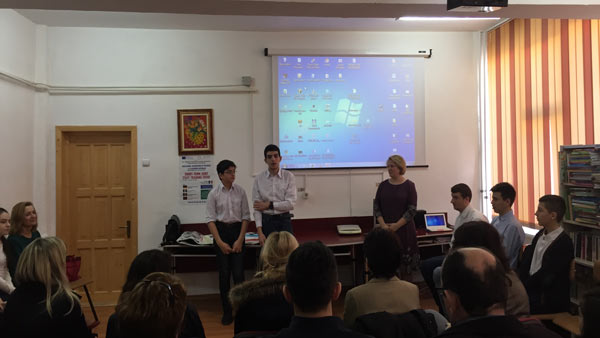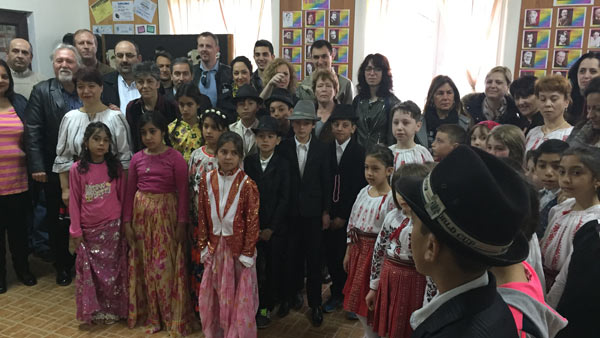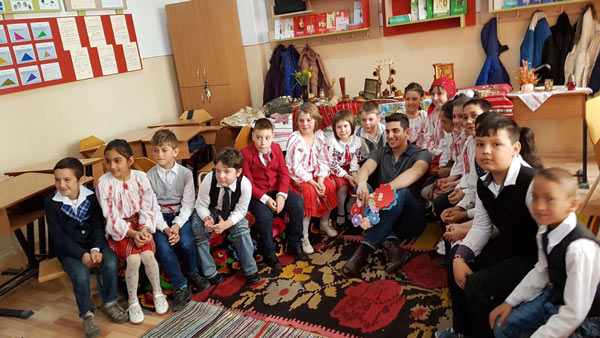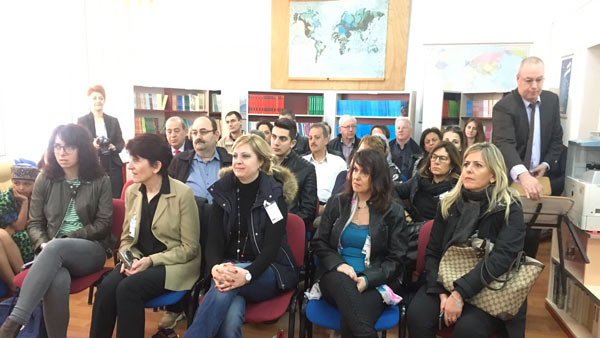On the first day all participants went to the Inspectorate for National Minorities in Romania. Here, after being warmly welcomed by theRomanian project coordinator and school inspector for educational projects, the group watched a really interesting traditional musical performance played by Roma students. Following this the coordinator of School Mediators, Mr. Sebastian Dâlcu introduced himself and the invited cultural mediators working in different county’s schools. This workshop was very helpful as it allowed participants to acquire a lot of information on the mediators’ official role,as well as on how they face the different problems arising during the roma students’ initial introduction to the schools to their gradual inclusion.
Later ,the participants met the president of Fundatia de Sprijin Comunitar: FSC ( Community Support Foundation), Mrs. Achihai Gabriela ,who introdused herself and her role in the Foundation.
Afterwards participants were given the possibility to ask questions to both mediators and their coordinator.and this moment really represented a great source of information for all project participants ,since in every country there are cultural mediators but it was great to talk with these Romanian ones and come in touch with their passionate involvement and catch their personal engagement.
Projects participants also went to the Institution of the Prefect Bacau where Mr SorinAileneiwelcomed them and talked about the presence of Roma people in their county and how they welcome and succeed in integrating them into the wider Romanian community.
The next activity in which the project participants were involved was the visit to the Domnita Maria Secondary School, actively involved in working with minority and disadvantaged groups.
Here the participants weretakn on a guided tour of the school. It was a really touching experience since every class had prepared a short performance for the Erasmus+ project guests and all participants were given small presents made by the children themselves.
On the second day we visited the Școala Gimnazială, Ciprian Prumbescu”, met teachers, the refugee students, their parents, school mediator and school counsellor. Refugee students made presentations about Syri, the culture, life style, etc.The also spoke about workig with their Romanian peers. After that they showed us some of their works together. Some teachers of the school presented work that they undertake in their classes. Parents and mediators also spoke about what they have achieved so far and what they feel about education of refugees in their area. It was interesting that the refugees welcomed us by waring their tradational clothing and prepared tradational food for the group. We could see that here was a very good example of integration. We observed that not only students and parents but also teachers, mediators givehight levels of importance the feelings of the refugees. There was a very clear emphaty with the refugee students and that the culture of the refugees and Romainin culture were both equally respected.
Later in the training week we departed to Buhusi to visit the Scoala Gimnaziala “Mihail Andrei”. The school has 430 pupils including a Kindergarten. 69,68% of the students are Roma. We visited 1stand 2ndgrade classes of the primary school and the Kindergarten. The school is working with Roma students for years and integrating them into the school system is not a new challenge. For example, many Roma parents do not see the need to send their children to school, because in their experience begging brings more money for them than working in an average job. They see it also as a more comfortable way to earn money. Therefore, the headmaster emphasizes that it is also important to sensitise the population for this problem, so that people do not give money to beggars and support them. As many Roma parents do not have a regular job and income, the school is also facing also a lot of social problems. Many pupils, for example, do not have proper clothes to wear to school or they do not have shoes. A Roma family can have many children, the parents do not work, they live in poverty. But poverty reasons are not only a Roma problem, there are also Romanian children at school, whose families have to deal with the same problems. All in all, the headmaster of Scoala Gimnaziala “Mihail Andrei” explains that the school is used to these challenges, because the Roma situation is something they are dealing with for years, so they were able to find solutions and structures to make it easier to deal with it. The school has also school mediators as a support and connection to Roma families and pupils.
After the visit at Scoala Gimnaziala “Mihail Andrei” we visited Milly’s Village of the Seniors. The old people’s home is not a classical example for integrations as we are dealing with it, but it is a good example of how inclusion can work. The concept of Milly’s Village is old people living together in a kind of community. The Village is constructed as a small farm, where the old people living there have certain tasks. They run the farm together and are looked after by a nursing staff. The idea behind this concept is to give the old people there the feeling they are needed.
The second management meeting of the EIR project also took place in Romania. Primarily this meeting was to review progress made in the project to date, identify work yet to be completed and to allocate these work tasks to the appropriate partners. In addition to this there were also a number of brainstorming sessions examiningtechniques that can be adopted for use in Refugee Educational Integration based on the partner experiences during the first year of the project. A number of areas for future investigation and piloting were identified:
Sport: build relationships, sense of belonging, sense of culture (indigenous sports), teamwork, communication / language, friendships, cost neutral, relatively easy to organise
Games: role play to gain understanding, play language (younger children), gamification (reward system)
Arts and Crafts: creates asense of achievement, does not require good language skills, can establish cultural identity
Fieldtrips: practical learning, learning by doing
Project based learning: group / teamwork can help self esteem and promote informal language learning
Integration of refugees own culture into all of the above: cultural awareness / sharing, integration needs to be seen to some degree as a two way process.
Mentors and Mediators: Either professional mediators or use of Peer Mentoring
Need to judge intelligence level: this is often difficult due to the language and cultural barrier
Social learning: Punctuality, relationships (cultural differences, number of children, marriage age etc.
Workplace training
Use of film in learning (possibility for subtitles)
School Newsletter incorporating refugee issues: increase understanding from other students, perhaps partly in the language of the refugee, with translation. Refugee involvement in production,
School Website or other social media, refugee input, refugees language and culture included
A number of issues were also raised by participants:
The question was raised as to how to manage if refugees have their own school and do not want to integrate
Some stressed the importance of teacher meetings to resolve and understand specific refugee problems
Communication with family/parents was of key importance and in some institutes there is a buddy system for both students and parents
In some countries there is a school for refugees and then transfer to ordinary school (Turkey). When these students transfer there is a policy to try to limit the number of refugees in each class
Partners at the meeting also visited the offices of Europe Direct for a workshop and discussion on inclusion. The work of Europe Direct in Romania was explained and examples of reports created to inform policy in Romania were presented. Romanian views on accommodating refugees and on the EU quota system were explained in detail as were the historic and cultural reasons for these views.










